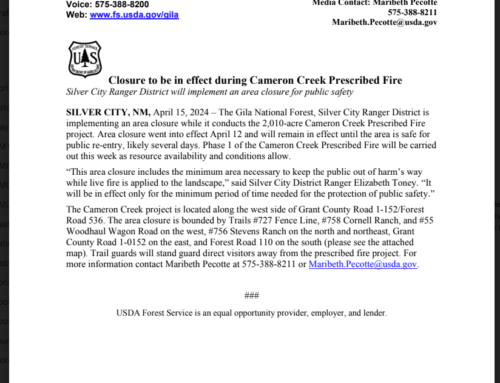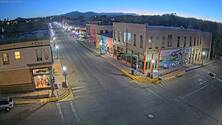Our goal here at Silver City Radio is to keep you, our listeners, up to date on the latest forest fire news.
The Spurgeon Fire that started on Monday, June 11th near milepost 38 on US Hwy 180, north of Alma in the Glenwood Ranger District covered 80 acres, and utilized variety of resources that included fire engines, a Type 3 Heliocopter and a utility chase truck. The fire was determined to be human caused and is 100% contained.
The Willow Fire that started on June 10th at 2:10 P.M, is currently burning on Willow Mountain and the headwaters of Willow Creek in the Whitewater-Baldy Fire scar of 2012 in heavy dead and down fuels. The majority of the fire perimeter is in the Gila Wilderness, and is covering 574 acres, using a total of 56 personnel, and is 0% contained. A weather pattern forecast is lining up to produce precipitation over the fire area Friday and Saturday. Along with the rain may come lightning, strong down draft winds and unstable weather conditions. Crews continue to prep and assess future needs for Willow Creek, Indian Creek and Bearwallow Lookout. The fire is primarily backing in all directions, primary growth is to the east and south. Minimal fire growth is expected during the anticipated weather event.
Regarding the Buzzard Fire that started on May 22nd, located 10 miles NE of Reserve in the Gila National Forest. According to the last report, the fire has covered 44,402 acres, is utilizing 383 personnel and has a containment of 74%. As control lines were connected and completed on the southwest side of the fire, crews conducted firing operations to burn out and secure the lines. These operations along with the fire burning in heavier fuels increased the smoke in the air on Wednesday. Local residents can expect a greater amount of smoke settling into low land areas during the evening and early morning hours. Firefighters continue to monitor the fire’s progression and prepare for further firing operations as needed to keep up with the fire’s spread.
With heavy rain predicted for the next few days, flash flooding from burned areas can quickly fill arroyos and stream beds. Drivers need to be aware of flooded stream crossings and NOT drive through them. The average automobile can be swept off the road in 12 inches of moving water. Roads covered by water are prone to collapse. Attempting to drive through flooded areas also may stall your engine. If you come upon a flooded road, take an alternate route.
Remember, smoke from fire rises up and away during the daytime, but in the evening smoke can pool back down in canyons, drainages, and basins. For information on air quality and protecting your health, and to find guidance on distances and visibility, please visit nmtracking.org/fire.
For more on these fires, check out nmfireinfo.com.



